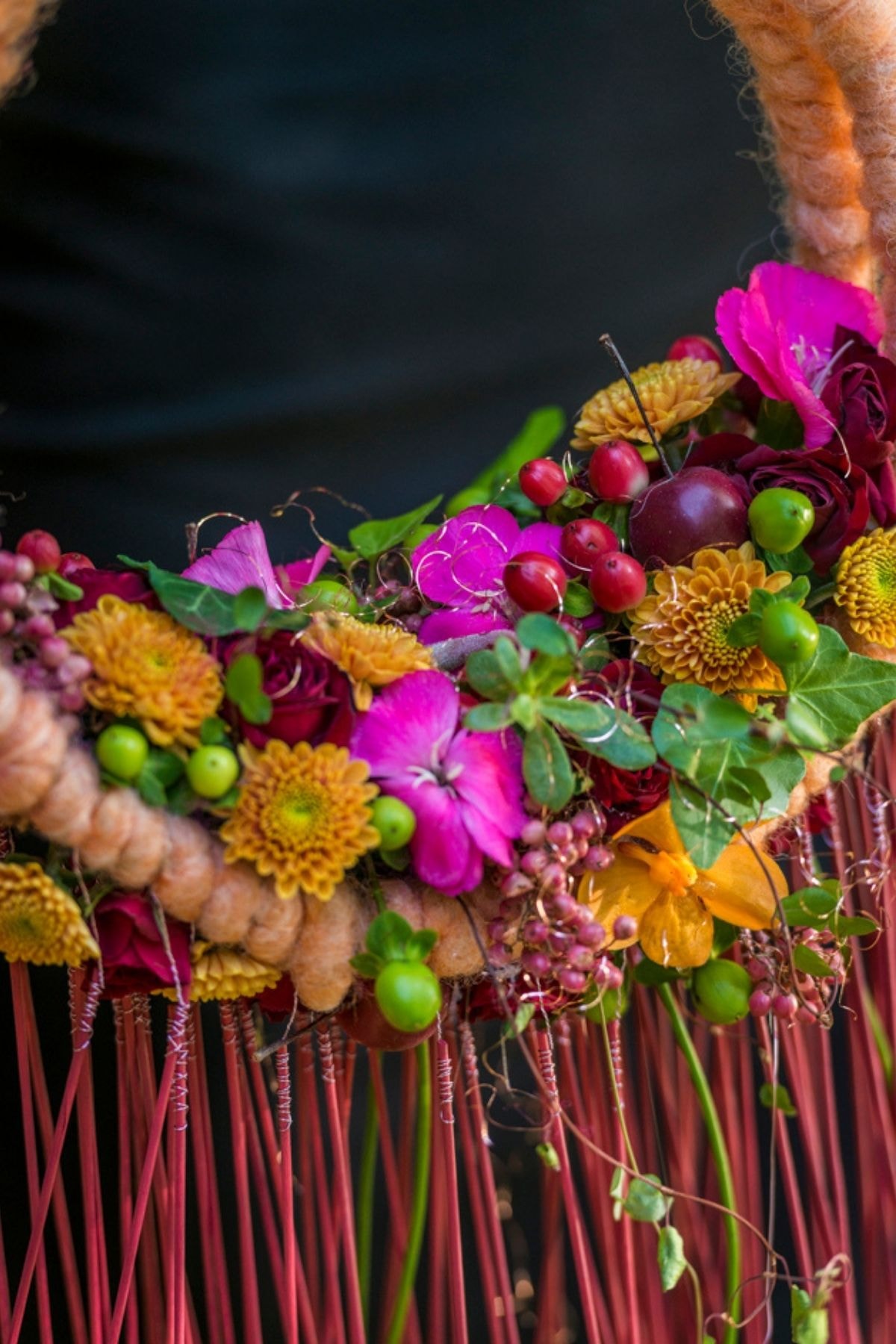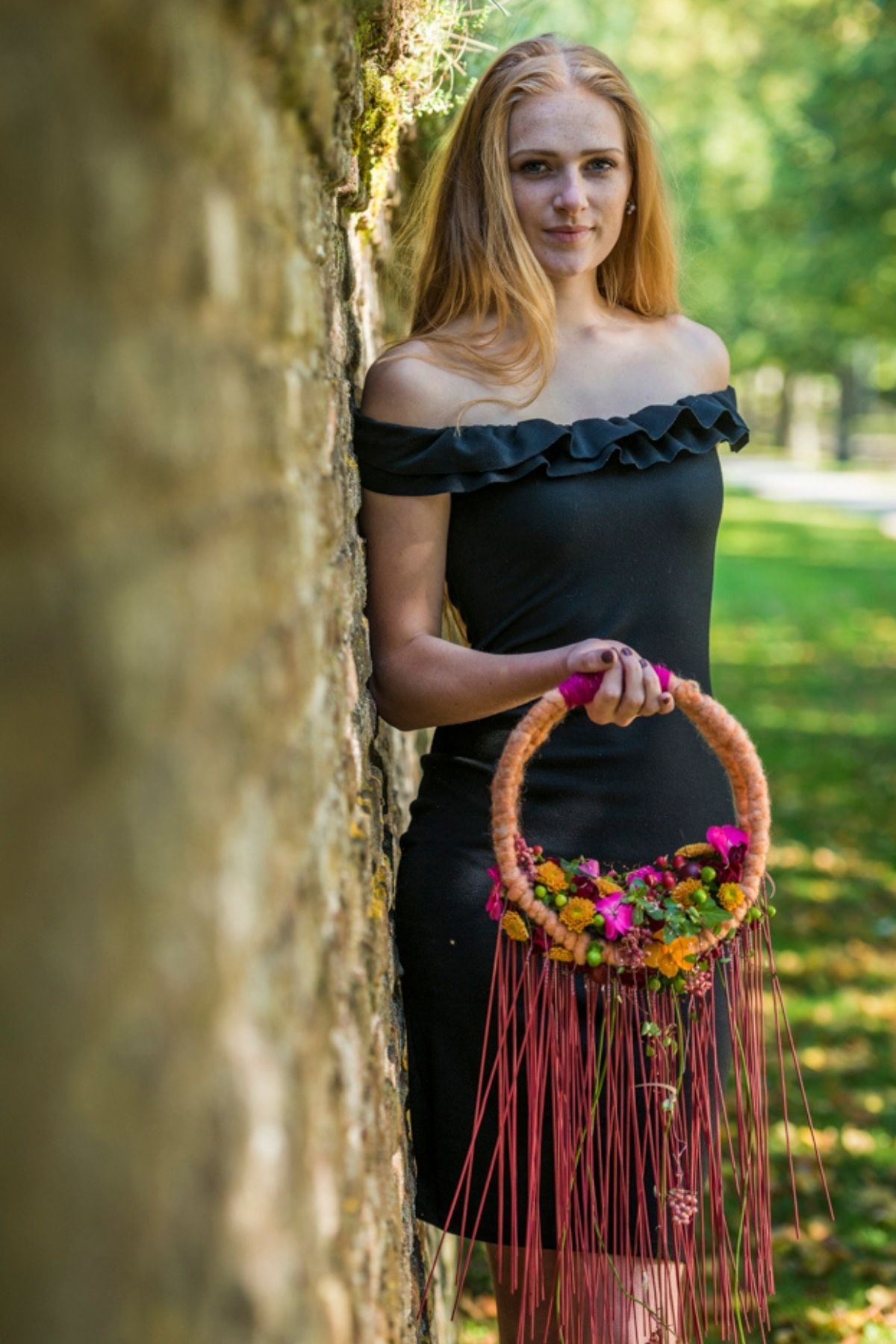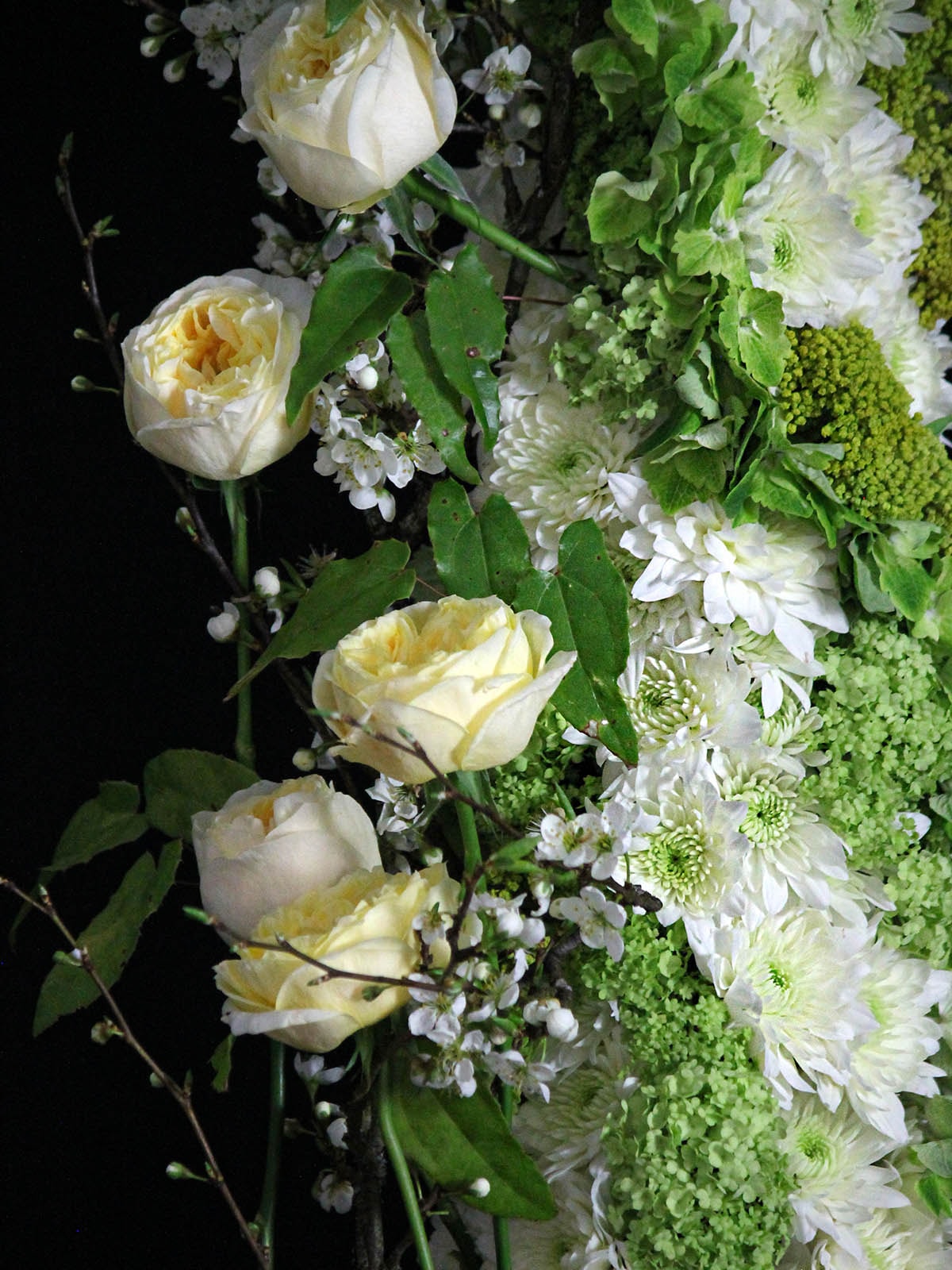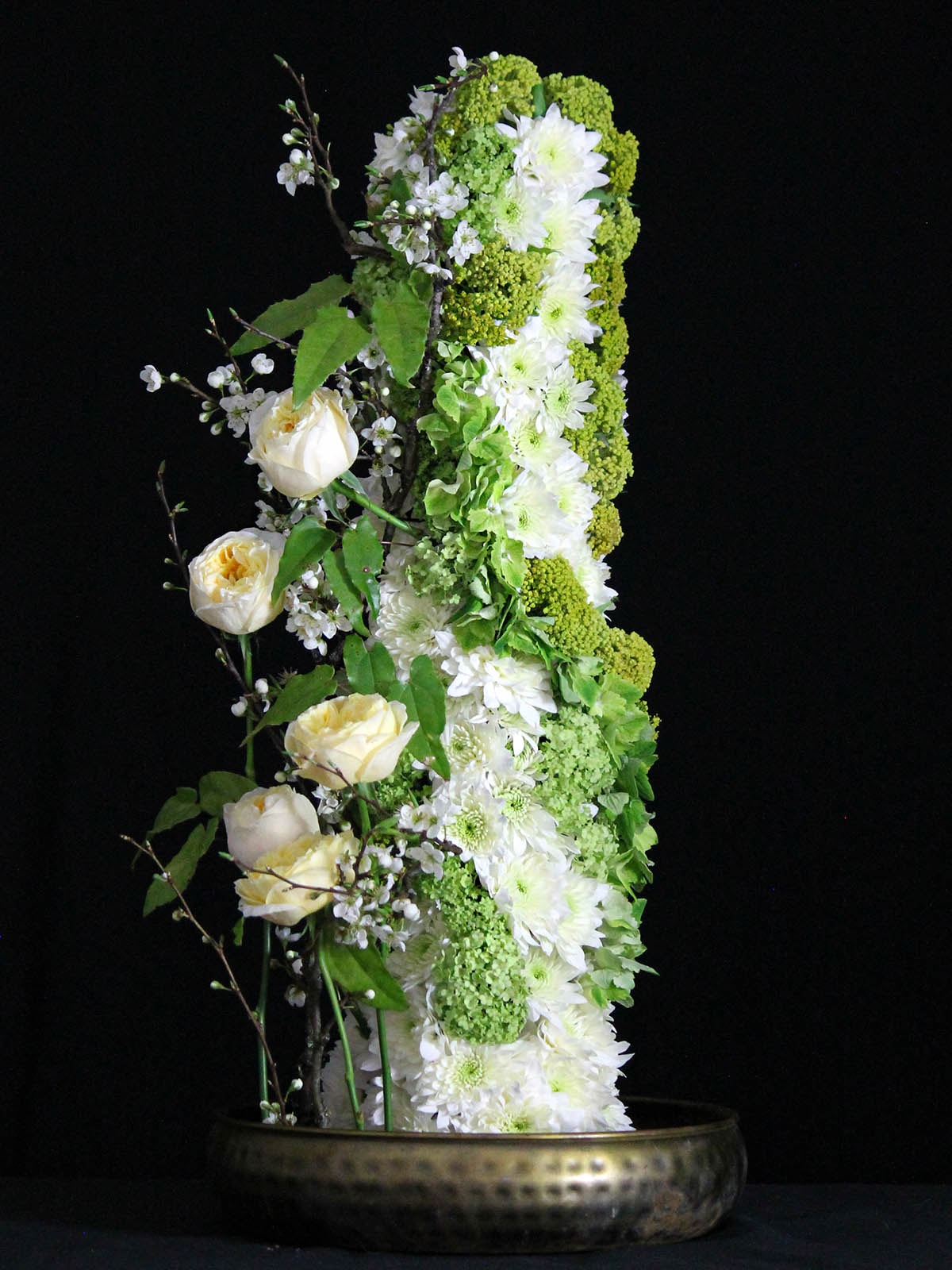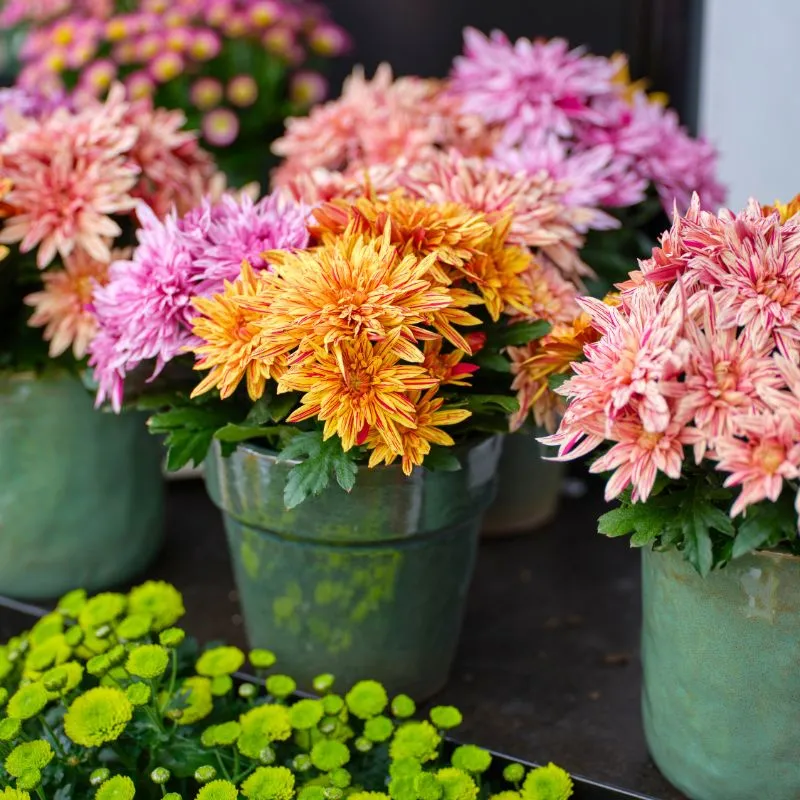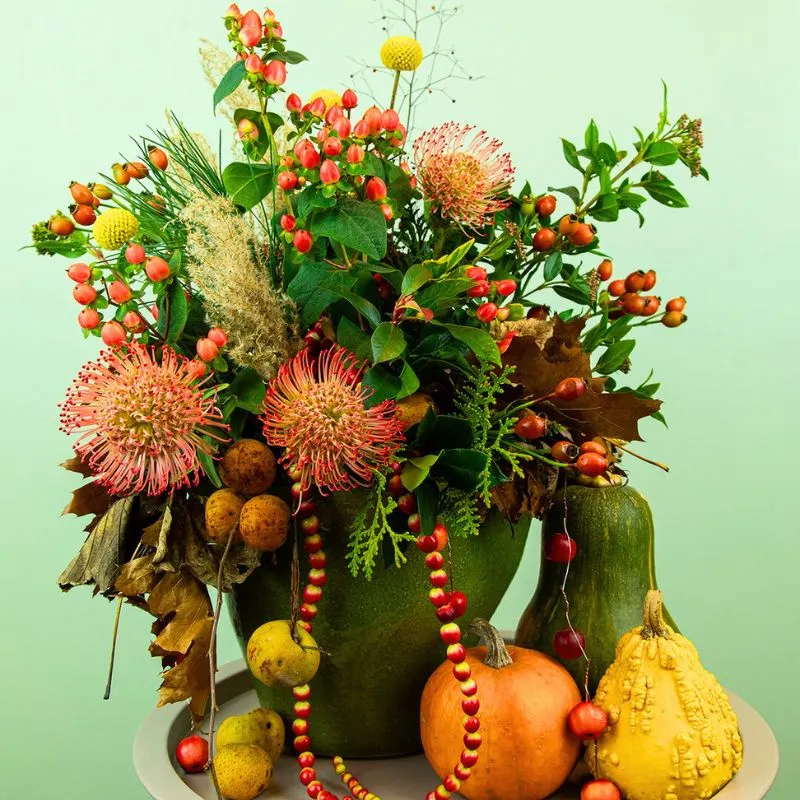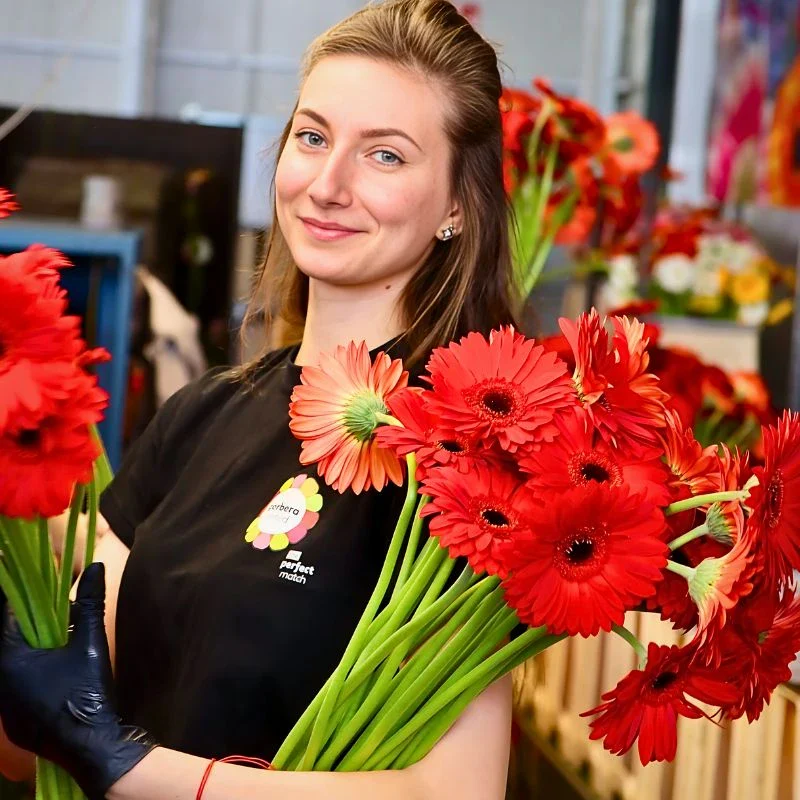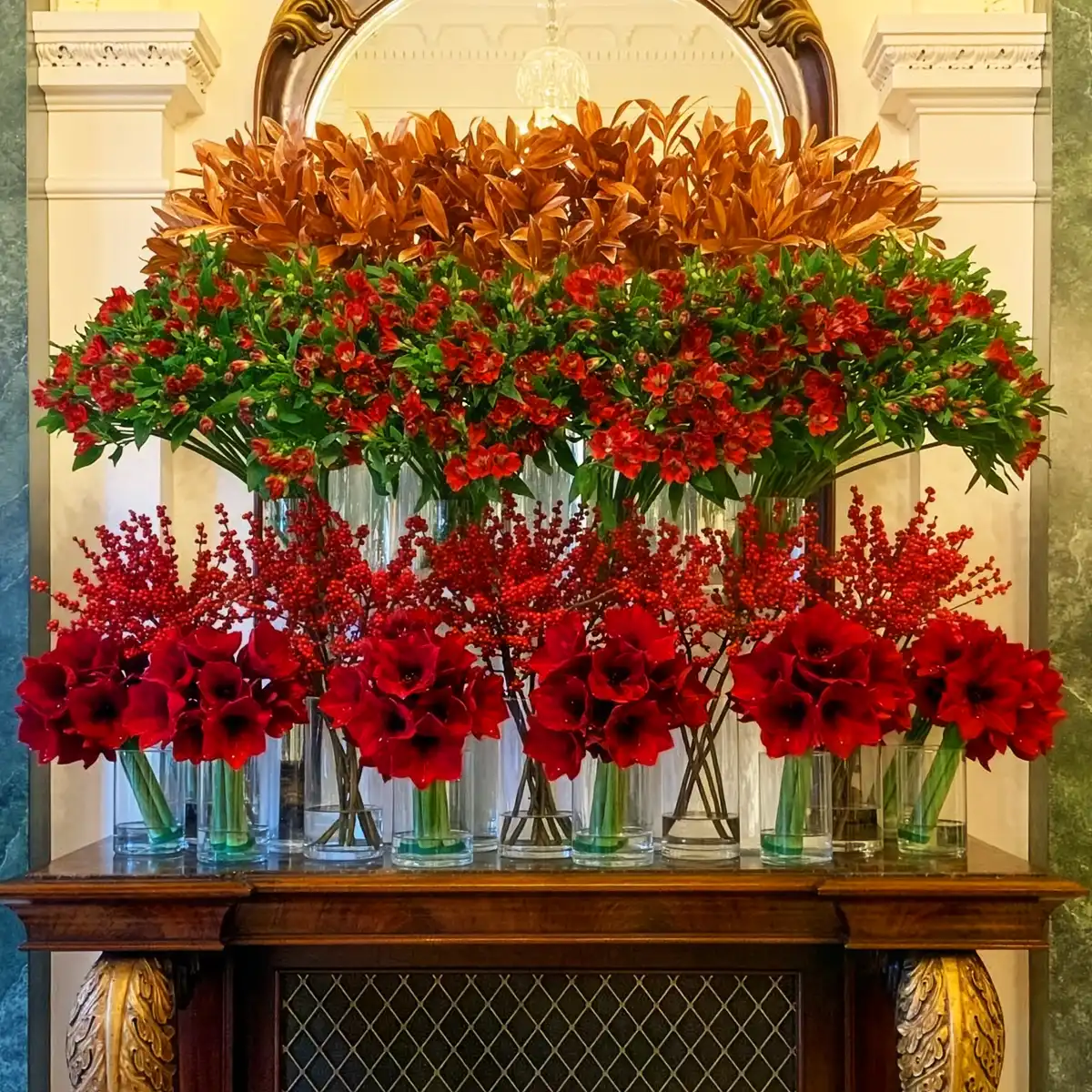Winters offer a unique opportunity to feature seasonal flowers that add romance and warmth during colder months. From rich garden roses to soft hellebores, these winter wedding flowers bring a fresh, inviting touch.
Each flower adds texture, depth, and sophistication, making winter wedding bouquets more than just arrangements; they reflect the season's beauty and your personal style. Selecting flowers in season ensures their freshness and supports sustainability at your celebration.
Top 20 Winter Wedding Flowers for a Dreamy Wonderland Bouquet
Crafting a winter wedding bouquet involves layering unique textures and rich colors. Winter flowers like white garden roses, ranunculus, and dusty miller offer soft tones and airy shades, while bold choices like deep burgundy Protea and blue thistle add dramatic depth.
Floral arrangements capture winter's magic by incorporating elements like silver Brunia and Eucalyptus greenery, making each bouquet a memorable part of your wedding day. Opting for in-season flowers also ensures each one stands out, creating floral arrangements that truly reflect the romance of a dream winter wedding.

Roses From Decofresh - Classic Romance for Your Winter Wedding Bouquet
Nancy Zimmerman, designer at Fancy Florals by Nancy, showcased Decofresh roses in a breathtaking wedding shoot, beautifully capturing their timeless appeal. Highlighted in one of our articles by Regine Motmans, Zimmerman's design features Decofresh varieties like the deep red Rose Venturoso, Violet Hill, and soft pink Pomarosa, each handpicked for their rich textures and romantic tones.
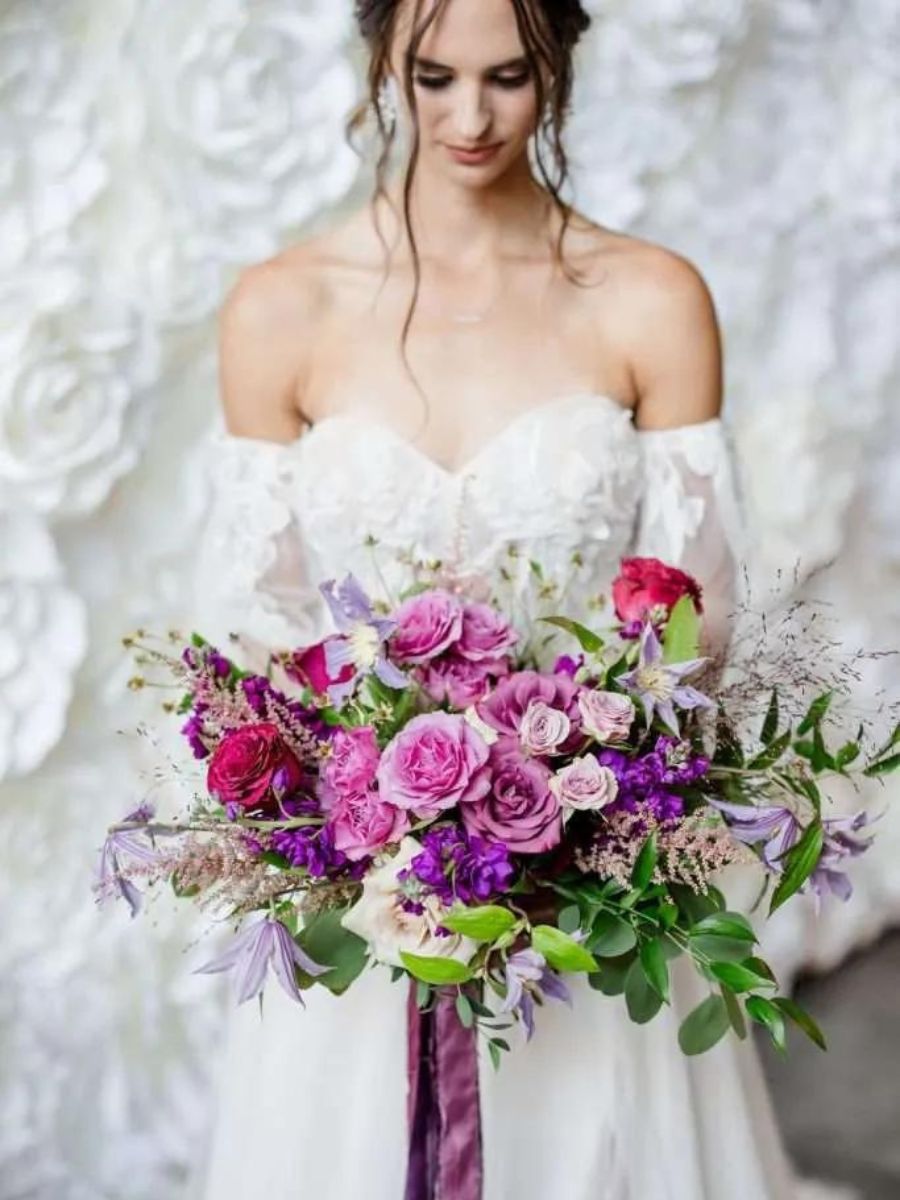
In the 'Vino Before Vows' photoshoot, Zimmerman added deep wine tones and grape details, creating a setting that radiated warmth and romance. About the design and flowers, Nancy says:
"We have long admired the beautiful rose varieties from Decofresh. And it seemed not possible for us to receive these beauties in the States. We also became a blogger for Thursd, and a member from myThursd, so we reached out to Regine to see if she could reach out to Decofresh to partner with us for this styled shoot at The Venue CU. We were delighted when we connected through myThursd's chat and Decofresh would indeed supply some roses."
Decofresh's roses, known for their quality of colors, offer a perfect balance of classic charm and luxury, ensuring that each bridal bouquet leaves a lasting impression. These roses stand out as winter wedding favorites, combining resilience and style to enhance the beauty of your special day.

Tesselaar Alstroemeria - Luxury for your Winter Wonderland Arrangements
Regarding luxurious winter floral arrangements, Tesselaar Alstroemeria offers an unmatched selection with its esteemed Alstro Special and Alstro Lux lines. Perfectly suited to winter weddings, these CO₂-neutral alstroemerias bring sophistication and sustainability to your bouquet. Cultivated by Rick and Karolien Tesselaar, this Dutch grower emphasizes both beauty and environmental responsibility, producing varieties like Alstroemeria Mistral. Mistral is known for its intense, snow-white petals and long vase life, so Mistral adds a soft glow to winter arrangements.

Florists love Tesselaar’s Alstroemeria for its rich colors, refined shape, and long-lasting blooms, which are ideal for creating opulent, snowy centerpieces or cascading bouquet designs. Notably, the Alstro Lux collection, with its heavy stems and robust blooms, is perfect for high-end arrangements, offering luxury with each petal. Wedding florists who seek versatility and depth often choose these alstroemerias, which bring both volume and brightness to winter floral decor.

For design inspiration, renowned designer Dmitry Turcan has showcased how Alstro Special can add a regal, open-bloom look to bouquets, making them ideal for wedding work. This mix of beauty and environmental consciousness makes Tesselaar Alstroemeria a beloved choice among florists worldwide.

Calla Lilies by Kapiteyn - Addition of 'Sleekness' to Winter Weddings
Known for their trumpet shape and velvet-like texture, calla lilies from Kapiteyn are celebrated for adding a contemporary edge to classic arrangements. As part of the Captain Calla series, these lilies come in striking winter shades like Captain Ventura (pure white), and Captain Beluga (ivory), ideal for creating a serene yet dramatic winter look.

Kapiteyn's Captain Calla Days offers insight into the latest trends in calla design, blending tradition with modern styles. Calla lilies, with their structured form, add a sculptural quality to bouquets, especially in minimalist, cascading arrangements. Kapiteyn's callas have also become popular for table decor and grand wedding arches, as their refined shape brings calm and style to any space, perfectly complementing a winter-themed wedding.

The winter season also features Christmas, and Ivan Bergh highlights the lily's role in creating appealing winter scenes. His designs feature calla lilies paired with natural winter accents like pine cones to reflect the magic of the season. He featured callas from Simply Calla growers to design the wondrous 'Crown of Advent and Shooting Star', a couple of designs that can also inspire you to blend something 'out of the box' when designing your winter wedding bouquet.

Clematis by Marginpar - Bringing in the Romantic Starry Accents
For those who want a touch of romance and whimsy in their winter wedding decor, Marginpar's Clematis Amazing® series offers a quality like no other. Clematis is known for its star-shaped petals and trailing vines, which add a delicate, almost magical feel to wedding designs.

Marginpar's varieties, such as Clematis Amazing® Geneva and Clematis Amazing® Miami, capture attention with their vivid colors and unique textures. These Clematis varieties have become a top choice for florists crafting romantic winter bouquets and airy hanging installations. Floral designer Krisztián Kövér has highlighted the Clematis in his designs, showcasing its flexibility and grace in airy, layered arrangements. Kövér's installations, often described as floating floral art, in this case, use clematis to create whimsical effects.

The Clematis Amazing® Vienna in pure white is particularly suited to winter wedding themes, lending a frosty, pristine feel to bouquets. Pair clematis with light greenery and other winter blooms to achieve a 'starry sky' effect, perfect for those magical wedding moments. With proper care, Clematis can last up to two weeks in arrangements, ensuring that it remains fresh for the wedding celebration and beyond.

'Coloured by Gerbera' - Making Wedding Celebrations Colorful
For a colorful, joyous touch in winter wedding decor, 'Coloured by Gerbera' presents a stunning array of Gerbera varieties, perfect for creating colorful, unforgettable floral displays. Known for their bright faces and cheerful colors, Gerberas add energy to any arrangement, whether used as focal blooms in bouquets or as accents in table settings. With a diverse selection, including single, double, and mini Gerberas, Coloured by Gerbera encourages florists to explore endless creative possibilities.

Florists, can match wedding palettes effortlessly with Gerberas' extensive color spectrum - from warm winter reds to delicate blush tones, each flower adds warmth and brightness to winter themes. The #gerberamoment campaign by Coloured by Gerbera also celebrates the versatility of Gerberas in wedding decor and highlights how these flowers can bring joy to any festive events.
Gerbera's long vase life and adaptability make them ideal for intricate bridal bouquets, boutonnieres, and even floral arches, ensuring that every corner of the wedding venue is filled with color and life. Want to check out some stunning closeup shots of gerberas? - Check this article that covers some amazing photographies of Gerberas.

Lisianthus by Decorum - Subtle Touch for Winter Wonderland Weddings
Lisianthus, often admired for its soft, rose-like petals, brings a gentle charm that’s ideal for winter wedding bouquets. Decorum’s lisianthus varieties, known for their durability and gentle layers, offer a thoughtful choice for brides seeking that soft, romantic touch amidst a snowy or wintry theme. Featuring a typical bouquet designed by Hanneke Frankema, using Lisianthus (Montana), roselilies (Moerman Lilium), and mini Gerberas (Jac Oudijk) with Chrysanthemums (Arcadia). She does not shy away from challenging traditional floral norms and 'thinking outside the bouquet' when it comes to floral designing.

Lisianthus works seamlessly with white roses and eucalyptus greenery, creating a visually stunning bouquet with an understated elegance. Whether used as the focal flower or in a supporting role with other blooms like Decofresh roses, Decorum’s Lisianthus provides a lasting freshness, perfect for winter weddings when fewer fresh flower options are in season.
With their varied color palette, including cream, soft pinks, and whites, Lisianthus are perfect for a winter wonderland setting. Use them to add that touch of winter softness to bridesmaid bouquets, boutonnieres, or even table arrangements. Here's another great example of making use of Lisianthus in combination with pink Phalaenopsis, burgundy Ranunculus, and purple vanda orchids to design a beautiful wedding bouquet - a design by Laura Draghici.

Helleborus - Winter's Rare Gem for Captivating Arrangements
For those looking to add a unique flair to winter wedding flowers, Helleborus is a rare gem. Known as the 'Christmas Rose', hellebores thrive in winter, providing colors that range from deep purples and greens to subtle whites and pinks. According to Marginpar, this bloom is a favorite for winter brides and florists for its charm and resilience.

Incorporating hellebores into wedding floral arrangements brings a blend of sophistication and seasonality. Their unique shapes and muted winter tones make them ideal for winter bouquets alongside Craspedia or anemones. In an interview, floral coach Amy Balsters mentioned hellebores as her favorite flowers! On a question on what flowers are her favorite and why, she says:
I would say Fritillaria, hellebores, and gardenias are high on my list of favorites. Fritillaria and hellebore have unique shapes, colors, and forms and are so feminine and strong.

Anemones by Floraprima - Add Contrasting Drama to Your Winter Wedding
Winter weddings often call for a dramatic, sophisticated touch, and Anemones by Floraprima delivers just that. Known for their striking black centers and bright petals, these blooms add a modern and bold contrast to softer flowers like white roses and lisianthus. As showcased in Floraprima's luxury collection, Anemones provide a pop of vibrant beauty, making them an excellent choice for brides who wish to incorporate unique and memorable flowers.

Floral designer Lil Caldwell of Grandirosa often uses Anemones for their contrast, adding depth to arrangements. She comments on anemones:
"At the more colorful end of the spectrum, anemones are very much having their moment in the spotlight too."

Pairing them with other Rosaprima blooms, such as ranunculus or their elegant range of roses, enhances their effect, creating eye-catching focal points. Anemones are ideal for winter weddings with romantic or minimalist themes, bringing a sophisticated touch that ensures your winter bouquet stands out with personality and charm.

Craspedia by Marginpar - Playful Pops of Sunshine
Marginpar's Craspedia Paintball™ Pop, known for its cheerful yellow spherical blooms, adds a playful pop of color to winter wedding floral arrangements. This flower, also known as billy balls, is loved by floral designers worldwide, such as Róbert Bartolen, for its bright, sun-like quality that brings warmth and energy to any design.

Craspedia's vibrant yellow hue is perfect for adding a fresh element to winter bouquets, offering a delightful contrast to the season's typically muted tones. Whether used in small pops within a bridal bouquet or as a focal element in table centerpieces, Marginpar's Craspedia instantly uplifts the mood, making it a go-to choice for floral artists seeking to create joyful, memorable arrangements. In addition, Craspedia pairs effortlessly with white roses, hellebores, and Ranunculus, adding a playful modern twist to traditional winter bouquets. Here's another wonderful design - 'Labyrinth of Wishes' by Dmitry Turcan using 3,000 Craspedias from Marginpar.

Ranunculus by Floraprima - Layered Romanticism for Your Winter Wedding
The Ranunculus varieties from Floraprima, particularly the Elegance Cioccolato and Cloni Success Hanoi, bring a lush, layered look to winter wedding bouquets. Floraprima’s Ranunculus is celebrated for its delicate, rose-like layers that embody romance and elegance. As Rosaprima shared during the SAF Phoenix event, the Cloni Success Hanoi variety has become a wedding favorite, praised for its ethereal pastel pink and white petals that bring depth and softness to floral arrangements.

Using Ranunculus in winter bouquets creates a luxurious feel that complements the season’s allure. The Elegance Cioccolato, with its warm, chocolate-brown tones, is ideal for adding warmth and sophistication to autumn and winter wedding themes. Paired with other Rosaprima roses or bright Craspedia, these Ranunculus varieties provide brides with an eye-catching centerpiece that captures the romance of winter and adds lasting beauty to the celebration.

Anigozanthus by De Ruiter to Blend the Unique Textural Accent for Winter Bouquets
For brides looking to introduce unique textures into their winter wedding bouquets, Anigozanthus by De Ruiter, also known as kangaroo paw, is a distinctive choice. Anigozanthus offers a rich, velvety texture and comes in various colors, from deep burgundy to golden hues, that suit winter themes beautifully. Kazi Sagar, winner of Master Florist Amaryllis Challenge 2023, uses unusual structures to turn this so-called filler flower into a centerpiece with his amazing bouquet arrangements.

Anigozanthus pairs well with classic blooms like roses or ranunculus, offering a contrasting texture that enhances the bouquet’s overall appeal. For winter ceremonies, it can be paired with spray roses from De Ruiter’s Bubbles series to create layered and textured arrangements. Its unique appearance adds visual interest, making it a popular choice among florists who want to introduce a fresh, dynamic accent to traditional winter floral designs.

Eryngium by Marginpar - Highlighting the Frosted Blue Spikes in Winter Looks
Bring a unique winter twist to your wedding bouquet with the frosted blue hues of Eryngium, also known as sea holly, offered by Marginpar. These striking spiked blooms carry a crisp, icy appearance that’s reminiscent of winter’s ethereal beauty. Eryngium’s steel-blue spikes create a bold visual and add texture to any arrangement, making them a favorite for florists looking to evoke a frosty, wintery effect. Marginpar’s commitment to sustainable and high-quality florals shines through in its selection, which is perfect for wedding designs that prioritize both beauty and environmental responsibility.

The above exhibited masterpiece is another great design from Krisztián Kövér using Eryngium Magnetar Questar®, smokebush, and Miscanthus White Cloud. Though suited much better for late summers, this can again be an inspiration for your winter wedding designs and decorations.

Want unique inspiration for designs with Eryngiums? You would want to check out the arrangements from 'Desert Retreat Moment' designed by BLOOM's using flowers from Marginpar. The cut flowers from Marginpar you can see in this wonderful upright design are Clematis Amazing® Blue Pirouette, Delphinium Blue Donna, Eryngium Orion Questar®, Eryngium Supernova Questar®, and Sanguisorba Red Dream.

Tulips and Winters are the Forever Pair
No flower symbolizes elegance in winter quite like the tulip. Known for their clean, cup-shaped blooms, tulips bring a graceful, timeless feel to wedding arrangements. Their versatility makes them ideal for both understated and elaborate designs, from classic white tulips that pair perfectly with eucalyptus to vivid jewel tones that add a pop of winter warmth.

This is what grower Winfried Versluis from Zwettulips has to say about tulips:
"It doesn't matter what color, whether they are double or fringed tulips. You always see the cheerful faces of people who receive a bunch of tulips. This makes me, like so many people, really happy with these flowers. My favorite? I'd say the double Tulipa Columbus!"

With varieties in colors ranging from soft ivory to rich crimson, tulips offer endless possibilities to complement the season's color palette. Embrace the charm of tulips in a simple bouquet tied with a velvet ribbon, or in a larger arrangement alongside baby's breath, adding a snowy softness perfect for winter weddings.
Floral designer Petr Anokhin tried a typical blend of luxury bouquets with traditional Kyrgyz style featuring a bouquet of snow-white tulips with Kyrgyz traditions filling in the backdrop!
FYI: Tulip is among the safest plants and flowers to grow in your garden. Want to check out other safe plants? Here is the link!

Roselily From Zaboplant - Doubling the Lavishness of Winter Weddings
When it comes to creating a lavish, romantic winter arrangement, the Roselily from Zabo Plant is an unparalleled choice. Known for its abundant double petals and pollen-free beauty, the Roselily brings an extra layer of elegance and sophistication to bridal bouquets. Zabo Plant has mastered the art of growing Roselilies, which not only exude opulence but also offer the benefit of hypoallergenic blooms, making them a hit among modern brides.

During the Dutch Lily Days, Zabo Plant showcased this exquisite flower as part of their signature collection, earning admiration from florists worldwide. The unique double bloom of the Roselily adds depth and volume, ideal for winter wedding arrangements that demand a luxurious look. Pair them with soft white Ranunculus or delicate sweet peas (Lathyrus) for a texturally rich bouquet that feels indulgent yet harmonious. Floral designers seeking a statement flower for winter weddings find Roselilies to be the perfect choice for a bold yet classic look.

Chrysanthemums - Marking a Bold Presence
Chrysanthemums have made their mark as a bold choice for winter weddings, standing out with their striking shapes and rich colors. With varieties like Chrysanthemum Santini Ellison in vibrant oranges and soft pastels, these blooms are adaptable to both rustic and opulent themes, adding a touch of resilience and vibrance to winter bouquets. Known for their excellent vase life and wide array of colors, chrysanthemums embody the season’s spirit with grace and endurance.
Floritec’s Santini Ellison Orange, a standout in bridal arrangements, provides florists with endless design possibilities, allowing for creative pairings with classic roses or winter greens like dusty miller and Eucalyptus.
Gaétan Jacquet, a designer recognized for his nostalgic take on Chrysanthemum designs, describes these blooms as versatile and 'easy-going', ideal for brides who want a bouquet that stays fresh throughout the festivities. Chrysanthemums bring a unique texture, whether arranged in a cascading style or a compact round bouquet, making them a top pick for winter floral designs. Here's another great inspiration Chrysanthemum bouquet by Natasja Mironova.

Hypericums to Get that Rustic Winter Touch
For those who desire a rustic, natural element in their winter bouquet, Hypericum, or St. John’s Wort, offers a perfect solution. Known for its vibrant berries in shades of red, pink, and even green, Hypericum adds a warm, earthy charm to winter wedding arrangements. The berry clusters bring depth and texture, often used as filler to enhance the bouquet’s fullness and seasonal feel. This versatile bloom also holds symbolic significance, representing resilience and hope, qualities cherished by brides.

Florist Jacqui O, known for her botanical and rustic styling, has incorporated Hypericum in many of her designs. The clusters of Hypericum berries complement darker, jewel-toned flowers like burgundy roses and deep purple anemones, adding a soft touch of warmth.
Their unique texture shines in winter bouquets, especially when paired with hardy greens like pine or olive branches. For a subtle pop of color that doesn’t overpower the design, Hypericum is a charming addition that rounds off a winter bouquet beautifully.

Salix - Twisting Branches for Winter Wedding Arrangements
Salix, also known as willow, brings an enchanting, whimsical feel to winter wedding floral arrangements. The twisted, graceful branches of Salix, especially the corkscrew and pussy willow varieties, add height and movement, giving a natural, organic structure to bouquets and displays. Ideal for winter weddings, these branches evoke a sense of frosty woodland magic, perfect for couples wanting to bring a bit of nature indoors.

Virve Holm created this wonderful waterfall shower bridal bouquet that exhibits creative lines of wired pussy willow catkins, crystal glass pearls, and snowdrops.

When arranged in tall vases or interwoven through centerpieces, Salix serves as a captivating base for adding seasonal touches like Eucalyptus or smaller, delicate blooms, achieving a harmonious wintery look. With its unique texture and shape, Salix aligns beautifully with winter’s calm, frosty atmosphere, making it a versatile, sophisticated choice for adding both structure and depth to winter wedding designs. Floral designer Katya Hutter masters the use of beautiful garden roses for luxurious wedding floral designs beautifully blending with salix arrangements to achieve a stunning result for the photoshoot.

Astrantia - A Starry Touch for an Ethereal Winter Bouquet
Astrantia, with its delicate, star-like blooms, introduces an ethereal charm to any winter wedding bouquet. Known for its romantic yet rustic appeal, Astrantia’s tiny, clustered flowers resemble small constellations, lending a celestial quality to floral arrangements. Its soft hues—typically white, pink, and lavender—enhance the subtlety of a natural, wintery palette, making it ideal for understated winter weddings.

One of the recent edition of Praxis Magazine by Germany’s floral authority BLOOM’s features Astrantia in several DIY bridal bouquets, showcasing its versatility and elegance. BLOOM’s DIY #1 bridal bouquet design with Astrantia Billion Star, Ceropegia Woodii, Eucalyptus Polyanthemos, and Gypsophila Xlence demonstrates how Astrantia adds a lush, layered effect to bouquets. This DIY encourages a creative approach, showing brides how to incorporate Astrantia with other winter blooms for a romantic, airy look.
Astrantia’s feathery quality is perfect for creating layered arrangements that feel light and magical, complementing both traditional and modern wedding styles. Its understated beauty and versatility make it a florist favorite for achieving a dreamy, snow-kissed effect in winter florals.

Protea - Bold Grandeur for a Showstopping Winter Arrangement
Protea, with its unique, architectural form, makes a bold statement in winter wedding arrangements. Known as 'nature's ancient beauty', Protea has been praised for its resilience and striking appearance, qualities that have made it a top choice for couples seeking a dramatic, eye-catching look. Floral designer Gaétan Jacquet calls Protea 'the botanical crown jewel', and for good reason—it symbolizes strength and adaptability, perfect for couples wanting to convey a sense of courage and endurance.

The King Protea, with its large, crown-like blossom, is an excellent choice for centerpieces, lending a regal air to wedding arrangements. Its hardy structure and bold colors, especially the white Arctic Ice variety by Ayoba® (featured in one of our articles on South African flowers), capture the essence of winter’s stark beauty. Paired with smaller winter blooms like Astrantia or accent greens, Protea transforms winter arrangements into showstopping displays, adding texture and height that commands attention. Protea’s combination of form and grandeur makes it an ideal focal point for winter bouquets and large floral installations, ensuring that your winter wedding décor remains unforgettable.

Hydrangea - Lush Petal Clouds for a Full Winter Wedding Look
Hydrangeas are beloved for their voluminous, cloud-like blooms that add instant fullness and elegance to wedding arrangements. Symbolizing grace and abundance, Hydrangeas bring a timeless quality to winter wedding bouquets.
The soft, rounded shape of Hydrangea heads fills out bouquets effortlessly, making them an ideal choice for brides aiming for a lush, overflowing look with minimal effort. Hanneke Frankema, a master florist known for her classic Hydrangea arrangements, appreciates Hydrangea’s ability to bring softness and sophistication to wedding displays, particularly in winter.

Hydrangeas work wonderfully with delicate greens and soft blooms, creating a romantic, cozy atmosphere reminiscent of snowy winter landscapes. Whether arranged in classic shades of white or blush for a traditional look or paired with deeper jewel tones for a wintery twist, Hydrangeas easily adapt to various wedding themes. Their long-lasting quality and ability to retain shape make them perfect for creating statement centerpieces or cascading aisle decorations, while their plush petals evoke the comfort and beauty of a winter wonderland. For those looking to add a touch of grandeur to their winter wedding, Hydrangeas - the queen of the garden, offers an unmatched elegance and timeless appeal.



